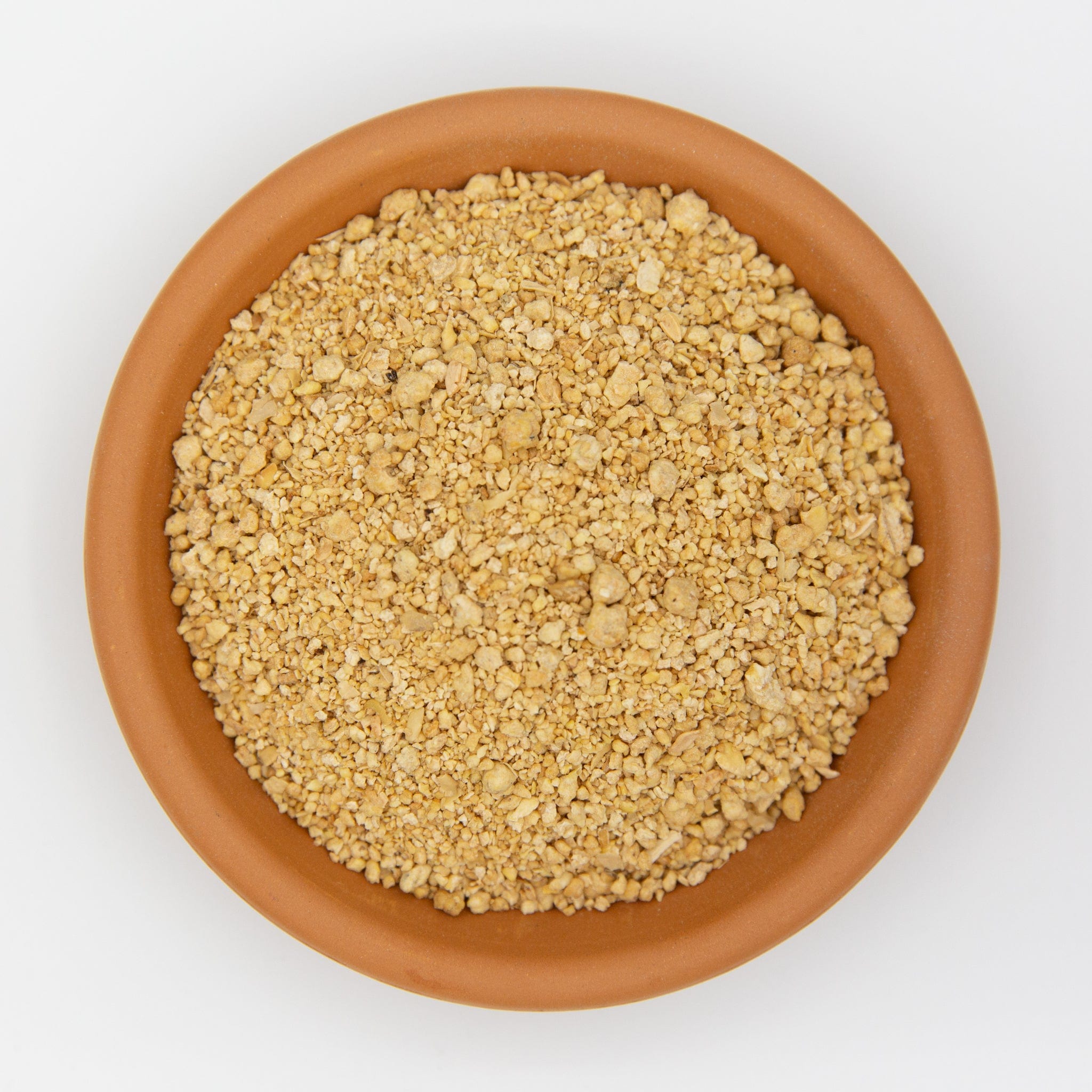Soybean Meal is the by-product of the extraction of soy oil. It is a natural fertilizer from sustainable resources. It is abundant in a wide range of vital nutrients, including as potassium, phosphorus, nitrogen, and many different trace minerals. By supplying vital nutrients and encouraging the development of advantageous microbes, soybean meal is renowned for its capacity to enhance soil health and fertility.
It is the perfect option to provide your plants with a high nitrogen boost!
It is perfect for growing leafy crops and is ideally incorporated into the soil 2-4 weeks before planting stage.
Soybean meal has a close to neutral pH making it a perfect no till or living soil amendment for fast vegetative growth and overall soil health.
Can be used as an effective compost activator.
Use 1/4 - 1/2 cup per meter squared
or 1/4 cup per 30 liters of potting soil.
Other advantages:
-
Soy bean meal contains a wide spectrum of vital nutrients, such as potassium, phosphorus, nitrogen, and a number of trace minerals.
-
It massively increases soil nitrogen levels and encourages the development of advantageous microbes.
-
Soy Mean can be utilized to increase plant output and grow luscious foliage.
-
Can be utilized as a natural source of nutrients with a fast yet sustained release.
FAQs:
What is Soybean Meal and why use it as a fertiliser?
Soybean meal is the protein-rich by-product left after oil is extracted from soybeans. In the garden it’s valued as a slow-release, plant-based nitrogen source that feeds soil microbes and builds long-term fertility.
What’s the typical N-P-K of soybean meal?
Most garden-grade soybean meals sit around 7-1-2 (N-P-K), i.e., high nitrogen with modest phosphorus and potassium — perfect for greens and veg in their leafy phase.
How much should I use in beds and pots?
From the product page: ¼–½ cup per m², or ¼ cup per 30 L of potting mix, ideally mixed in 2–4 weeks before planting. That’s a sensible, low-risk starter rate for living soils.
Is soybean meal fast or slow release?
Slow and steady. University work on organic N sources (including soybean meal) shows mineralisation ramps up over weeks, with meaningful release through ~8 weeks as microbes do the work.
Can soybean meal burn plants?
It’s gentler than synthetics, but heavy, fresh applications right on seedlings can inhibit germination or cause tip burn. Mix in and pre-apply, or side-dress lightly once plants are established.
Soybean Meal is good for which crops?
Leafy greens (lettuce, kale, spinach), brassicas, herbs, and any veg needing a nitrogen nudge in veg phase. That’s exactly why this product is pitched at “leafy greens.”
Will Soybean Meal work for fruiting plants?
Yes — but it’s a veg-stage tool. Switch to a more balanced or K-forward program as plants move to flowering/fruiting so you don’t overdo N and suppress blooms.
Can I use Soybean Meal on lawns? How much?
Yes. Home lawn users commonly spread ~4.5–10 lb per 1,000 ft² (≈ 220–490 g per 10 m²) per feeding and water in. Start at the low end and observe.
Is Soybean Meal suitable as a compost activator?
Absolutely. It’s a great “green” (nitrogen) input to wake up a carbon-heavy pile. Add thinly and mix to avoid clumps and odour. Evidence-based compost sources note high-N meals (alfalfa/soy) work well as activators.
Does Soybean Meal smell?
A little “malty/earthy” at first. If you dump heavy and get rain you may notice a temporary whiff — it fades in a few days as microbes chew through it.
Will Soybean Meal attract pests or rodents?
Any organic fertiliser made from grains/proteins can interest pets/rodents if left on the surface. Mix it in and water, and store bags sealed.
Is Soybean Meal safe around pets?
Plant-based meals are generally less risky than blood/bone, but any fertiliser can cause GI upset if eaten. Keep pets off freshly treated areas and store products securely.
Will Soybean Meal change soil pH?
Soybean meal is basically near-neutral and won’t swing pH on its own. Always pair with soil testing over time.
Does Soybean Meal add micronutrients too?
Yes — besides N-P-K you’ll get small amounts of trace minerals plus carbon to feed microbial life.
How soon before planting should I apply?
Mix it in 2–4 weeks ahead to let microbes start breaking it down so seedlings don’t sit on raw protein.
Can I side-dress mid-season?
Yep. Scratch a light handful into the top few cm of soil around plants, water in, and give it 1–2 weeks to show effects as it mineralises.
What about seed starting or young transplants?
Be gentle. Use well-balanced seed-starting media and avoid heavy soybean meal directly in germination zones to prevent inhibition.
Is soybean meal okay for hydroponics?
Not recommended. Particulates can bio-foul lines and clog pumps; hydro systems prefer fully soluble mineral nutrients unless you’re running specialised bio-active setups.
Is Soybean Meal GMO-free or certified organic?
We don’t claim third-party certifications on this page. If you require GMO-free or certified inputs, reach out to our team for batch details before purchase.
Can I brew Soybean Meal into a “tea”?
You can, but we don’t recommend it: anaerobic brews made from protein meals can go funky fast and don’t out-perform simply mixing the meal into soil/compost where microbes work aerobically.
How long does Soybean Meal feed?
Expect a gentle feed for ~6–8+ weeks depending on temperature and biology. Warmer, biologically active soils release N quicker.
How does Soybean Meal compare to blood meal for greening?
Blood meal is much hotter (~12-0-0) and works quicker but can burn and is very pet-attractive. Soybean meal is slower/safer, and entirely plant-based.
Will Soybean Meal help poor, lifeless soil?
Yes — as part of a system. Soybean meal feeds microbes and adds organic matter; pair with compost/mulch and good watering to rebuild structure and biology.
Can I mix Soybean Meal with other amendments?
Common pairings are with balanced organic blends or K-sources later in the season. Avoid stacking lots of high-N inputs all at once — stagger them.
Is Soybean Meal good for Australian native plants?
Use caution with phosphorus-sensitive natives (Grevillea, Banksia, Hakea, Waratah). Soybean meal is low P, but even small amounts can stress sensitive Proteaceae. If in doubt, use native-specific, very low-P fertiliser.
What’s the best way to apply?
Broadcast the measured amount, mix into the top 5–10 mm, and water in. In pots, blend evenly through the mix at the recommended rate from the product page.
How much nitrogen does Soybean Meal actually deliver?
At ~7% N, 1 kg of soybean meal contains about 70 g of nitrogen. Extension math examples use soybean meal as a reference slow-release N source when planning bed totals.
Will Soybean Meal stain hard surfaces or smell indoors?
It can leave a light residue if watered on paving — sweep up before watering. For indoor plants, use sparingly and incorporate fully to manage odour.
How should I store Soybean Meal?
Cool, dry, sealed. Reseal between uses to prevent moisture wicking (clumping) and to keep out rodents.
Is Soybean Meal okay for edible gardens?
Yes — it’s a straightforward plant-derived amendment widely used in veg beds. Rinse harvest as usual and follow good hygiene.
Can I use Soybean Meal in no-till/living soil beds?
It’s ideal — sprinkle, rake in lightly, cover with mulch. That keeps microbes fed without disturbing structure.
Any quick conversion help for my area?
As a rough guide: ¼ cup ≈ 30–35 g of soybean meal (varies by grind). If you want to get precise for big beds/lawns, use an application-rate calculator to translate rates to your area and bag size.
Why not just rely on compost?
Compost is awesome for structure and biology but is usually N-limited. A measured dose of soybean meal supplements N without harsh salts, especially for lush veg growth.
Any reason not to use it?
Skip heavy applications at seeding time, be careful with Proteaceae natives, and don’t use it in hydro systems. Keep pets away until watered in and the surface dries.



